Sustainable growth rarely happens by chance. It takes foresight, structure, and a clear understanding of where to focus effort. Without a defined plan, even strong teams risk chasing opportunities that pull resources in too many directions and deliver little long-term value.
A business development plan provides the foundation for intentional growth. It turns ambition into an actionable roadmap for market expansion, product launches, and strategic partnerships. A well-structured template brings consistency to that process, combining market insights, measurable milestones, and team alignment in one place.
This article outlines how to build a business development plan that drives real progress — from defining objectives and analyzing your market to creating strategies that connect long-term vision with daily execution.
Key Takeaways
- Define a focused plan: create a business development plan centred on growth strategies with clear timelines and measurable goals, rather than a full operational business plan.
- Research with purpose: conduct targeted market analysis to identify opportunities, calculate your addressable market, and uncover competitive gaps.
- Turn strategy into action: translate high-level goals into executable plans with defined ownership, milestones, and success metrics.
- Enhance visibility and automation: use monday work management to track progress with AI insights and real-time dashboards that connect strategy to daily work.
- Review and adapt regularly: assess progress each quarter to adjust for market shifts and maintain momentum through continuous optimization.
What is a business development plan?
A business development plan is a strategic roadmap for expanding your company through new markets, partnerships, products, or customer segments. It provides clear direction for how to grow beyond current operations, outlining the specific actions, resources, and goals that turn long-term vision into measurable progress.
It’s helpful to image it as your growth playbook. While a business plan template covers everything about running your business, a business development plan template zeros in on expansion opportunities and how you’ll capture them.
The core purpose breaks down into three growth drivers:
- Strategic growth roadmap: maps out your path to new markets with specific milestones and action steps.
- Revenue acceleration: pinpoints opportunities to boost sales through targeted initiatives.
- Resource allocation: shows where to invest time, budget, and people for maximum impact.
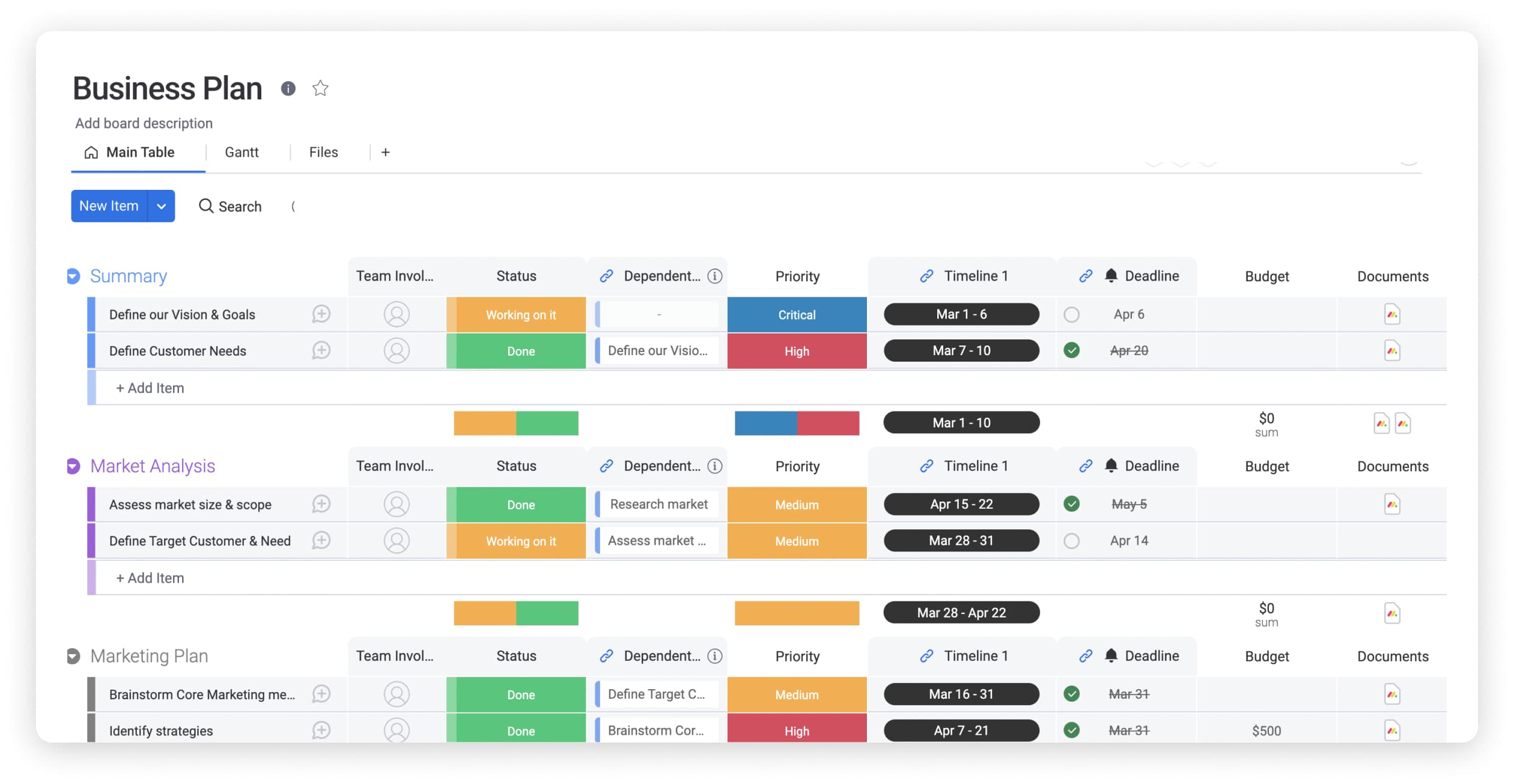
Business development plan vs business plan
While both documents guide company direction, they serve very different purposes. A simple business plan template lays the foundation for how your organization operates — detailing structure, finances, and overall management. It is the blueprint for running the business day to day.
A business development plan, in contrast, builds on that foundation. It focuses on how the company will grow, exploring new markets, products, and partnerships that expand reach and revenue.
Here’s a closer look at how they differ:
| Eelement | Business plan | Business development plan |
|---|---|---|
| Scope | Entire business operations | Growth initiatives only |
| Timeline | 3-5 year overview | 1-2 years with quarterly checkpoints |
| Audience | Investors and lenders | Your team and partners |
| Key metrics | Overall profitability | Growth KPIs and market share |
This distinction matters because each document drives different outcomes. A free business plan template can help secure funding and establish operations. Business development plans drive expansion and competitive advantage.
Key components of a business development plan template
A business development plan works best when each section builds on the next. These components create a structured framework for researching opportunities, defining strategies, and executing them with precision.
The sections below outline what to include in your plan — from market analysis and growth strategies to financial projections and resource planning — so every decision supports sustainable, measurable growth.
Market analysis framework
Your market research forms the foundation for growth decisions. Include target market demographics, market size calculations, and competitive landscape analysis.
Strong market analysis reveals opportunities competitors miss. It validates your assumptions with real data rather than guesswork.
Growth strategy sections
Detail your strategic approaches — market penetration, product development, market expansion, or diversification. Each strategy should address different growth scenarios with specific implementation tactics.
Consider how strategies complement each other. The right combination creates momentum that accelerates overall growth.
Sales and marketing plans
Connect sales processes with marketing campaigns for unified customer acquisition. Your plan should cover lead generation, conversion optimization, and customer acquisition costs (CAC), aiming for a healthy LTV: CAC ratio of at least 3:1 to ensure your growth initiatives are profitable.
Cover lead generation, conversion optimization, and customer acquisition costs (CAC), aiming for a healthy LTV: CAC ratio of at least 3:1 to ensure your growth initiatives are profitable.
Make the link between your marketing plan efforts and revenue explicit. Show exactly how each campaign contributes to growth targets.
Financial projections and ROI
Include revenue forecasts, investment needs, and return calculations that justify your initiatives. Base projections on market research and past performance, not wishful thinking.
Break down requirements by quarter. This supports budget planning and resource decisions throughout implementation.
Implementation timeline
Use an action plan template to structure your timeline with milestones, dependencies, and deliverables. Include quarterly goals and monthly checkpoints to maintain momentum.
Build in contingency plans for potential delays. Your timeline becomes the roadmap teams follow during execution.
Resource management components
Address team capacity, budgets, and technology needs. Show how you’ll support growth without overwhelming current operations.
Plan for both immediate needs and future scaling requirements as initiatives gain traction.
5 steps to create your business development plan
A structured approach transforms good ideas into achievable growth. These steps build on each other to create a complete business strategy template.
Step 1: define business objectives and KPIs
Set specific growth goals that align with your company strategy. Your objectives might include revenue targets, market share goals, or customer acquisition numbers.
Choose KPIs that accurately track progress. Monthly recurring revenue growth, customer lifetime value, and market penetration rates give you real insight into performance.
Make objectives ambitious yet achievable based on market analysis and team capacity.
Step 2: analyze your market and competition
Research market opportunities and competitive threats thoroughly. Use customer surveys and interviews alongside industry reports.
Develop frameworks to evaluate competitor pricing, positioning, and advantages. This analysis reveals market gaps and customer needs you can address.
Document findings in formats that support ongoing planning. Markets change, so your analysis should too.
Step 3: identify target customers and value propositions
Understanding your customers is essential for defining where and how to grow. Go beyond surface details to uncover what drives their decisions and how your business can meet those needs.
Key actions to take:
- Build detailed personas: include pain points, motivations, buying behaviors, and decision-making processes.
- Define value propositions: explain how your offering solves each segment’s challenges better than competitors.
- Tailor your approach: adjust messaging, sales tactics, and communication channels to match each audience.
Step 4: develop growth strategies
Turn market insights into actionable strategies. Consider organic versus acquisition growth, direct sales versus partnerships, and product versus market expansion.
Prioritize based on resources, timeline, and potential impact. Each strategy needs specific tactics, metrics, and resource requirements.
Step 5: create implementation roadmap
Convert strategies into executable plans with defined ownership and deadlines. Sequence initiatives for maximum impact while managing dependencies.
Include regular review points to assess progress and adjust based on performance data.
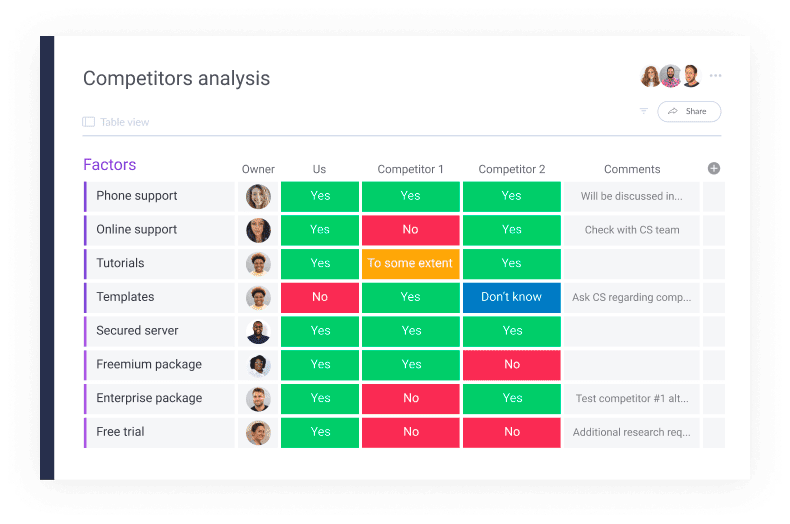
5 powerful business development plan templates
The right template can streamline your planning process and ensure you don’t miss critical elements. Here are five specialized templates to accelerate your business development efforts:
Strategic growth roadmap template
This template visualizes your long-term growth journey with milestone tracking and dependency mapping. Perfect for complex initiatives requiring cross-functional alignment, it helps teams see how individual projects contribute to broader business objectives.
Market expansion planner
Designed specifically for companies entering new markets, this template includes sections for regional analysis, localization requirements, and market-specific competitive insights. It structures your expansion approach with phased implementation timelines.
Partnership development framework
This template streamlines the process of identifying, evaluating, and activating strategic partnerships. It includes partner qualification criteria, value exchange modelling, and relationship management workflows to maximize alliance outcomes.
Product growth accelerator
Built for companies focusing on product-led growth, this template connects product development with go-to-market strategies. It helps teams prioritize features based on market impact and align development timelines with marketing campaigns.
Revenue optimization blueprint
This template helps businesses increase revenue from existing customers and markets before expanding into new ones. It provides a structured approach to improving profitability through smarter pricing, retention, and customer value growth.
Key areas to include:
- Pricing strategy: evaluate and adjust pricing models to reflect value and market demand.
- Upsell and cross-sell pathways: identify natural opportunities to expand customer relationships.
- Retention initiatives: strengthen loyalty through improved customer experience and ongoing engagement.
How to build your market research foundation
Solid research prevents costly mistakes and identifies your best opportunities. monday work management’s templates help organize market data and track competitive intelligence systematically.
Calculate total addressable market
Use the TAM, SAM, SOM framework to size your opportunity. Total Addressable Market shows overall demand. Serviceable Addressable Market reflects what you can realistically target. Serviceable Obtainable Market indicates what you can capture now.
Base calculations on industry data, government statistics, and competitive analysis. Accuracy matters more than optimism when sizing markets.
Identify market trends and opportunities
Spot emerging trends and changing customer behaviors that create openings. Distinguish temporary shifts from lasting changes worth strategic investment.
Monitor industry publications, customer feedback, and competitor moves. Document trends with evidence and assess their impact on your marketing planning.
Analyze competitor positioning
Evaluate direct and indirect competitors comprehensively. Study their pricing, positioning, strengths, and weaknesses.
Use these insights to refine your value proposition template. Find gaps where you can establish clear advantages.
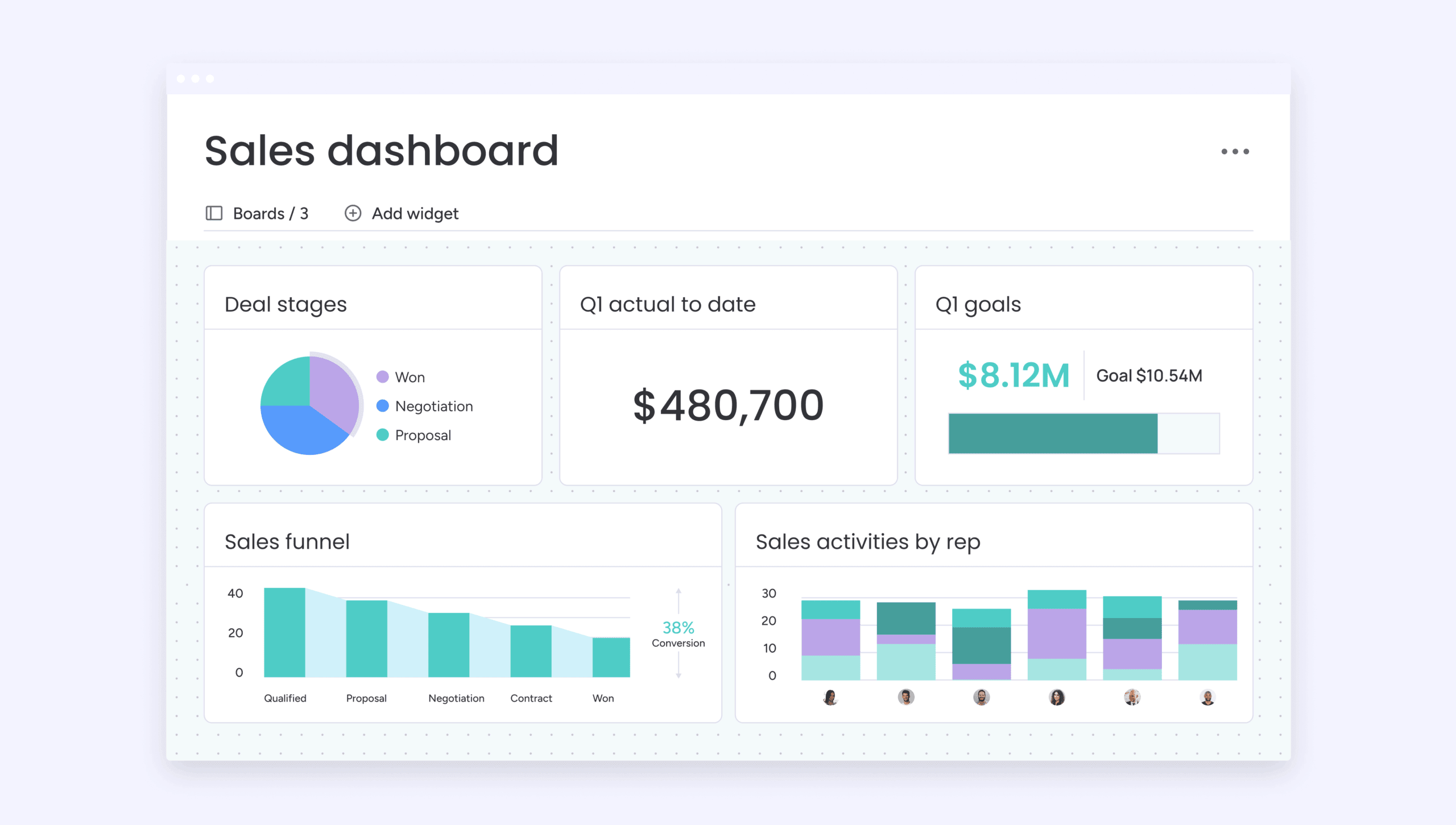
Design customer-centric growth strategies
Strong market research gives every business development plan a solid starting point. It reveals the right opportunities, reduces risk, and ensures decisions are guided by real data rather than assumptions.
Using modern work management systems like monday work management helps bring structure to that process. Teams can capture market insights, organize competitive analysis, and track research progress in one place: turning scattered information into clear direction for strategy and execution.
The steps below outline how to size your market, analyze competitors, and uncover opportunities that drive focused growth.
Create detailed buyer personas
Develop profiles that capture what drives customer decisions. Go beyond demographics to understand pain points, buying processes, and evaluation criteria.
Validate personas through interviews, surveys, and behavioral data. Keep them current as markets evolve.
Map customer acquisition channels
Evaluate channels from digital marketing to partnerships and direct sales. Assess each based on cost per acquisition, conversion rates, and customer quality.
Diversify across touchpoints to reduce dependence on any single channel. Consider how channels work together throughout the customer journey.
Develop partnership opportunities
Strategic partnerships can accelerate growth by expanding reach and resources without significant internal investment. Focus on relationships that create mutual value and align with your business goals.
Key steps to take:
- Identify potential partners: look for organizations whose capabilities, customers, or markets complement your own.
- Evaluate fit and value: assess how collaboration can fill gaps or strengthen your offering.
- Structure for mutual benefit: define shared goals, responsibilities, and success measures to ensure long-term impact.
Plan product or service expansion
Identify expansion opportunities for existing customers or new markets with a development plan template. Use systematic analysis to find customer needs and market gaps.
Balance innovation with resource constraints. Expansion should increase customer value while opening new revenue streams.
Transform strategies into action plans
Effective strategies only deliver results when they are translated into clear, executable steps. Success depends on structured planning, defined ownership, and measurable progress.
Using connected work management systems like monday work management helps teams bridge the gap between strategy and execution. Complex initiatives can be broken down into projects, milestones, and responsibilities that everyone can see and track in real time.
The advice below outline how to turn your business development strategy into an actionable plan that drives measurable outcomes.
Break down initiatives into projects
Decompose growth initiatives into projects with clear deliverables and timelines. Scope projects realistically while maintaining strategic alignment.
Map dependencies to identify critical activities and potential bottlenecks.
Assign team ownership
Distribute responsibilities based on skills and capacity. Clear ownership prevents initiatives from stalling.
Document assignments to maintain accountability throughout implementation.
Set milestones and dependencies
Plan checkpoints that keep projects on track. Build buffer time for complex activities.
Regular milestones create opportunities to assess progress and adjust course.
Establish success metrics
Define measurable outcomes that connect to business development objectives, a critical step given that employees who understand how success is measured are 2x more likely to feel motivated. Include leading indicators for early warnings and lagging indicators for final results.
Create reporting systems for regular updates and quick decisions when results vary from expectations.
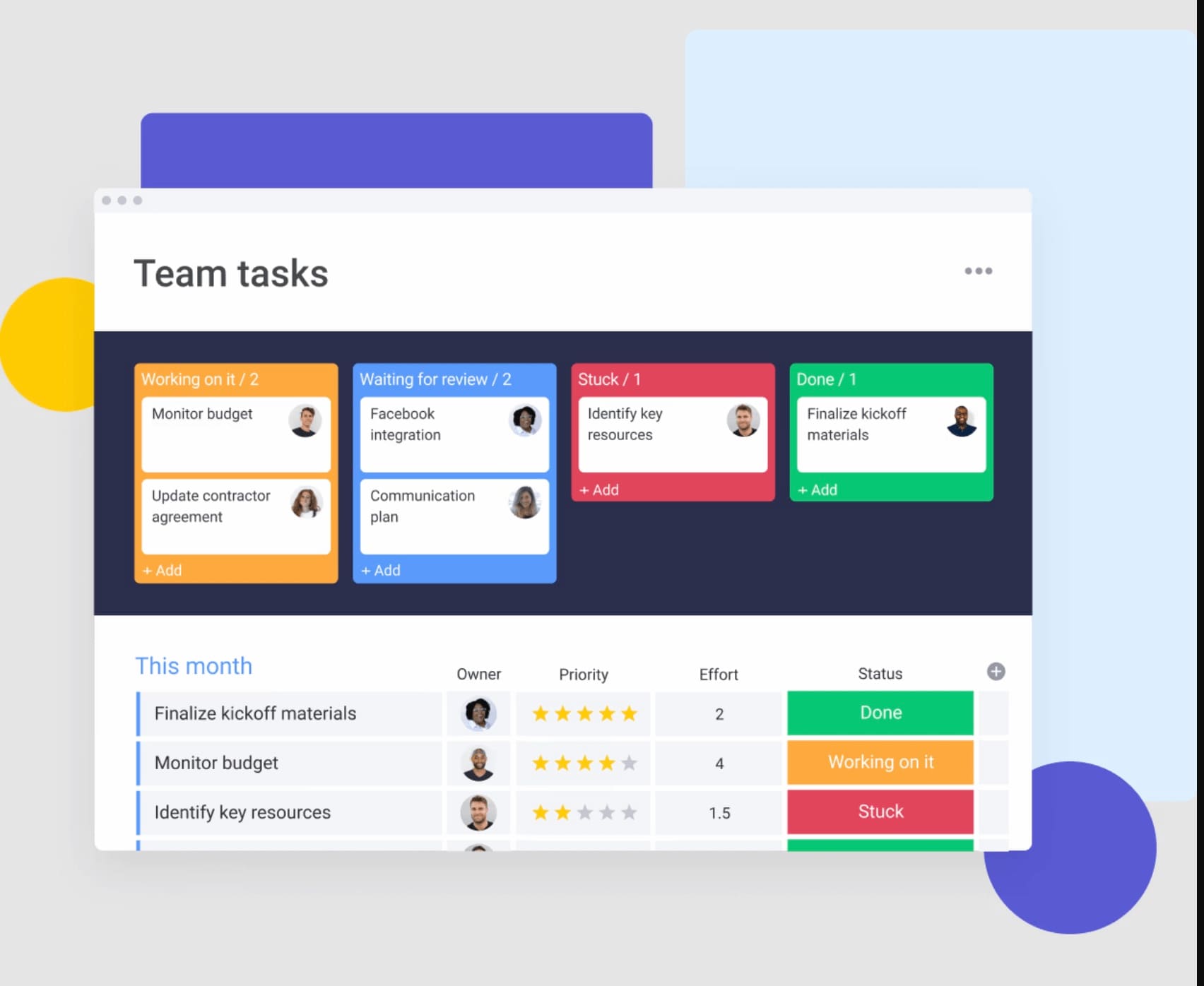
Allocate resources for maximum impact
Smart resource allocation maximizes ROI while maintaining operational stability.
Consider these key areas when planning resource distribution:
- Team capacity: assess skills and availability to support growth without burnout.
- Budget priorities: balance high-impact initiatives with operational needs.
- Technology requirements: choose platforms that scale with your growth.
Work management solutions like monday work management help visualize capacity, balance workloads, and optimize resource allocation across projects to keep teams focused where they add the most value.
Plan team capacity and skills
Identify capability gaps that could limit success. Plan for hiring, training, or outsourcing to fill needs.
Develop models that account for current work plus growth requirements.
Distribute budget by priority
Create allocation strategies with clear investment criteria. Include contingency funds for unexpected opportunities.
Budget flexibility enables quick response to market changes while maintaining discipline.
Select technology and platforms
Choose technology that supports scalability, efficiency, and long-term growth. The right systems make it easier to manage complexity as your business expands.
Work management platforms like monday work management bring planning and execution together in one place, helping teams coordinate efforts, share information, and move projects forward with greater clarity.
Track and optimize performance
Long-term growth depends on consistent evaluation and data-driven refinement. Tracking performance highlights what drives results and where adjustments are needed to stay on course.
The following practices show how to monitor key metrics, review progress regularly, and adapt strategies to keep growth initiatives performing at their best.
Monitor KPIs with live dashboards
Set up tracking systems for real-time visibility into growth metrics. Design dashboards highlighting critical indicators with drill-down capabilities.
Focus on metrics driving business outcomes, not vanity numbers that look good but don’t guide decisions.
Schedule regular review cycles
Establish monthly operational reviews and quarterly strategic assessments. Create structured agendas covering performance, resources, and opportunities.
Reviews become learning opportunities that improve future planning.
Adapt strategies based on data
Interpret performance data to make informed adjustments. Know when to pivot, double down, or abandon approaches based on results.
Transform experience into organizational knowledge that improves decision-making over time.
Business development plan examples by industry
Business development looks different in every industry. The priorities, challenges, and growth levers that drive success in technology, professional services, or manufacturing often vary widely. Adapting your plan to these nuances ensures strategies align with market realities and deliver measurable results.
The examples below highlight how different industries structure their business development plans, and what each focuses on to achieve sustainable growth.
Technology and SaaS example
Software companies often structure plans around product-led growth and strategic partnerships. Focus areas include free trial acquisition, expansion revenue, and integration partnerships.
Prioritize rapid scaling and market share over immediate profitability.
Professional services example
Consulting firms and agencies emphasize relationship building and thought leadership. Growth comes through referrals, content marketing, and complementary partnerships.
Expand client relationships and develop new services with a consulting proposal template leveraging existing expertise.
Manufacturing and B2B example
Manufacturing and B2B companies grow by strengthening existing relationships and optimizing how products reach the market. Success depends on balancing efficiency with long-term customer value.
Key focus areas include:
- Distribution channels: expand reach through reliable partners and optimized delivery networks.
- Product line extensions: introduce complementary offerings that increase customer lifetime value.
- Supply chain optimization: improve coordination, reduce costs, and ensure consistent quality.
- Customer retention: build long-term contracts and service models that promote loyalty and stability.
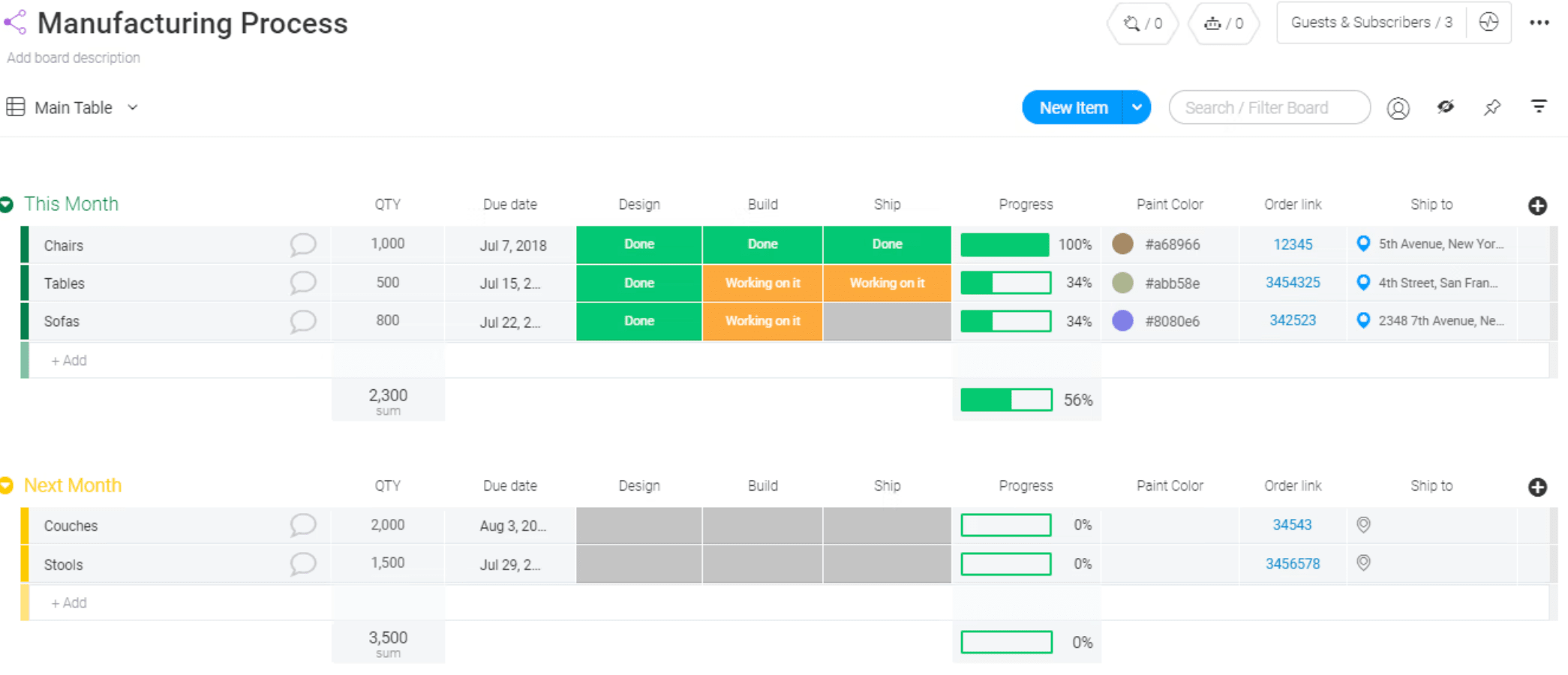
Accelerate business development with monday work management
Modern business development depends on structure, visibility, and the ability to adapt quickly. A strong project management template connects strategy to execution so teams can stay focused on the right opportunities.
With connected work management systems like monday work management, those plans become living workflows. Teams can automate tracking, visualize performance, and collaborate across departments — keeping growth initiatives aligned and moving forward.
Automate plan tracking with AI capabilities
AI features automate tracking, categorize opportunities, and generate insights without manual analysis, tapping into a growing sentiment where 80% of Millennials believe AI can help them do their jobs better. AI Blocks summarize research, extract customer insights, and prioritize leads by strategic fit.
Reduce administrative work while improving strategic decisions through pattern recognition.
Visualize progress with custom dashboards
Real-time dashboards show business development metrics, project progress, and resource use instantly. Visual tracking keeps teams aligned without manual updates.
Display the metrics that matter most — from pipeline progression to acquisition costs.
Collaborate across teams in real-time
Enable seamless collaboration between sales, marketing, product, and executives through shared workspaces. Integration with existing applications connects planning to your broader technology ecosystem.
Cross-functional visibility unifies teams and maintains alignment with growth objectives.
Scale strategies with intelligent automation
Automation handles routine activities while Digital Workers monitor lead quality and suggest resource shifts. These features let teams focus on strategic work while operational details get consistent attention.
Frequently asked questions
How often should I update my business development plan?
Business development plans need quarterly reviews and annual updates to stay relevant. You should adjust more frequently during rapid market changes or when performance metrics show strategy modifications are needed.
What's the difference between a business plan and a business development plan?
A business plan covers your entire business model including operations, finances, and management. On the other hand, a business development plan focuses specifically on growth strategies and expansion opportunities with shorter timelines and targeted initiatives.
Can I use the same business development plan template for different industries?
The core framework stays consistent, but you should customize sections based on your industry dynamics. Healthcare companies need different regulatory considerations than technology firms, and B2B strategies differ from B2C approaches.
How long should a business development plan document be?
Business development plans typically run 15-25 pages for full documentation with two to three page executive summaries. Focus on actionable content rather than hitting specific page counts — quality matters more than length.
Which platforms help implement business development plans?
Project management platforms, CRM systems, and analytics applications support execution through structure, tracking, and measurement. monday work management offers comprehensive features for planning, executing, and monitoring initiatives across teams.
How do I measure business development plan success?
Track success through revenue growth, market share gains, customer acquisition rates, and ROI on initiatives. Monitor both leading indicators like pipeline growth and lagging indicators like closed revenue for complete effectiveness measurement.
 Get started
Get started 

